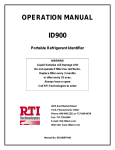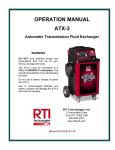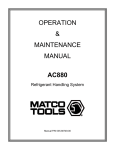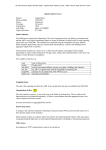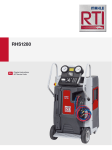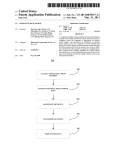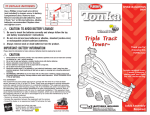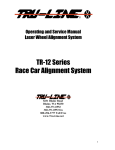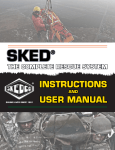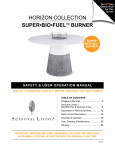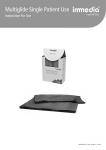Download Nitrogen Tire Filling Systems - Automotive Equipment Svc Co Inc
Transcript
Nitrogen Tire Filling Systems Providing you with the best solution for offering nitrogen tire filling! Increase profits and vehicle count. Show your customers that you are on the forefront of automotive technology and safety with twice the productivity per vehicle. Why choose anything else? Provide your customers with • Proper Inflation 3-4 Times Longer • Increased Safety • Superior Handling • Improved Fuel Economy • Longer Tire Life • Decreased Wheel Corrosion Offers the Complete Nitrogen Tire Filling Package High Purity Nitrogen Production and Delivery System RTI NitroPro Purity Assurance • Generates nitrogen on-demand using shop air source • On-board tank for storage of generated nitrogen • Eliminates need to purchase nitrogen • Innovative membrane for optimal purity and long life • Triple filtration system for additional purity and membrane longevity • Auto-shutoff for less compressor use and greater energy savings • Portable design with nitrogen inflated tires and front lockable casters • Easy operation for increased productivity (NTF-15 Models) Exclusive RTI Tire Deflation and Vacuum System • Deflators quickly and simultaneously deflate four tires to atmospheric pressure • Vacuum System removes more residual air than traditional nitrogen systems • Removes more detrimental moisture • Increases speed of service—twice as fast as double deflate/double inflate systems! • Better purity in the tire! 1. Temperature stability. The RTI NitroPro’s membrane performs consistently over a wide temperature range. The performance of competitors’ membranes drops off significantly in cool garage shop environments. 2. Age Stabilization: Most membranes age over years and continue to decline in performance. The special NitroPro polymer membranes however are fully aged in just eight weeks and stabilized at a high performance level before shipment in a NitroPro machine. This helps maximize and maintain the NitroPro’s high nitrogen purity for many years to come. 3. Contamination Protection: The NitroPro membrane has a large bore. This means that the fiber is less susceptible to contamination damage than that of other membranes. NTF-15 pictured left and NTF-60 shown above. NitroPro includes 20 samples of Premium Chrome N2 Valve Stem Caps, Tire Deflators, Point-of-Purchase Flyers and a Bay Banner! RTI NitroPro N2 Purity Tester Specifications Air Supply 100 to 150 psi (6.9 to 10.3 bar) required • Convenient and reliable hand-held device Controls 2 Ball valves (with an intuitive silkscreen) Vacuum Venturi generator (17 InHg max) • Quickly and accurately tests nitrogen tank purity Service Time (per vehicle) (average tire size**) NTF-15: 7 minutes average NTF-15 Plus: 7 minutes average NTF-60: 7 minutes average NTF-60 Plus: 7 minutes average Tires per hour* (average tire size**) NTF-15: 32 tires NTF-15 Plus: 77 tires NTF-60: 36 tires NTF-60 Plus: 87 tires • Quickly and accurately tests tire purity • Provides your customers with a professional display, validating your service NitroPro Hose Reel (P/N 436125) 50 ft. of “Nitrogen Green” 3/8 in. I.D. nitrogen hose with adjustable hose stop. Contact RTI to see what model is perfect for you! NTF-15 NTF-15 Plus NTF-60 NTF-60 Plus P/N 455-80009-00 (New Product—Call For Availability) P/N 455-80010-00 P/N 455-80006-00 Air Regulator Kit P/N 355-80070-00 Premium N2 Valve Stem Caps (Qty. 200) P/N 436075 Point-of-Purchase Flyers (Qty. 1,000) P/N 944005 NitroPro N2 Purity Tester P/N 436050 NitroPro Hose Reel P/N 436125 Storage Tank Capacity NTF-15 & NTF-15 Plus: 15 gal (56.8 ltr) NTF-60 & NTF-60 Plus: 60 gal (227 ltr) Nitrogen Purity Level Minimum 95 to 98% (from membrane) Hose Coiled Green Air Hose (18 ft working length) (5.5 m) Dimensions NTF-15 & NTF-15 Plus: 49 in x 20 in x 22 in (125 cm x 51cm x 56 cm) (H x W x D) NTF-60 & NTF-60 Plus: 52 in x 20 in x 27.5 in (132 cm x 51 cm x 70 cm) (H x W x D) Weight NTF-15 & NTF-15 Plus: 155 lb (70 kg) NTF-60 & NTF-60 Plus: 220 lb (100 kg) ** Maximum tires per hour, including tank refill. ** Average tire size for data: 225/60/R15. All models can service more small tires per hour and fewer large tires per hour than specifications listed. The Most Productive and Profitable Solution. Why is the industry switching to nitrogen? How nitrogen works and what it does Nitrogen (N2) makes up the majority of the air that we breathe and is contained in the protein of all life on earth. It is colorless, tasteless, and non-toxic. The next most common component of air is oxygen (O2). Together N2 and O2 make up approximately 99% of the air we breathe and traditionally fill tires with. N2 is a larger molecule than O2. Therefore, it cannot escape as easily as oxygen through porous material such as a rubber tire wall (carcass). Leaking at a much slower rate than oxygen, a tire filled with a higher percentage of N2 maintains its proper pressure roughly three to four times longer than air-filled tires. Proper inflation provides better fuel economy, superior handling, longer tire life, and increased safety by reducing the likelihood of low pressure related loss of control, blowouts and other tire failures. N2 is a dry, inert gas. O2 in a tire provides unwanted oxidation. Over time, this reaction destroys the tire carcass and corrodes wheels. A tire is prematurely aged by O2 from the insideout as the pressurized air in the tire makes the O2 try to escape through the tire carcass, speeding up the damaging oxidation process. N2 on the other hand, is a harmless inert gas that does not react negatively with tires and wheels. N2 filled tires also reduce tire heat, thereby decreasing rolling resistance and increasing fuel economy. N2 is non-flammable. O2 is a flammable gas while N2 is an extinNON-FLAMMABLE guishing gas. Thus, a GAS large number of mass transportation companies around the world fill their tires with N2 for added fire and explosion safety. In a vehicle fire, ruptured air-filled tires fuel the fire. N2 filled tires slow the fire. N2 has been used in tires for many years on aircraft, military vehicles, off road trucks, racecars, and even Tour de France bicycles. Nitrogen inflated tires are safer and longer lasting than tires inflated with air • Nitrogen inflated tires do not age as quickly as air inflated tires • Nitrogen inflated tires minimize blowouts • Nitrogen inflated tires improve vehicle handling through proper inflation • Nitrogen is an inert, non-combustible and non-flammable gas • Nitrogen is a stable gas providing more constant pressure • Nitrogen is a dry gas with no corrosive properties as found in compressed air Correct inflation versus under-inflation Correct inflation is highly significant when considering tire life Under-inflated and performance. It is not always possible to look at a tire Correctly inflated and detect under-inflation. However, under-inflation can cause many tire-related problems. As inflation pressure largely determines a tire’s load capacity, under-inflation results in an overloaded tire. An underinflated tire operates at high deflection resulting in decreased fuel economy, sluggish handling and may result in excessive mechanical flexing and heat build up, leading to catastrophic tire failure. Facts & Testimonials “The RTI NitroPro machine is great. After looking at NADA and other sources, we found it more versatile than other nitrogen tire systems. We sold 588 services in our first full month at $29.95 each. That more than paid for both of our machines in their first month of operation.” —Sammy Hayes, Service Director, Sam Galloway Ford Dunn Tire L.L.C. is pleased with its nitrogen decision. Dunn Tire charges $5 per tire. So far one store in two months sold more than 1,100 nitrogen fill-ups, which adds up to about $5,500. Mr. O’Neill added that the fill-ups will pay for the equipment in a “very short period of time.” —“Dealers: N2 inflation gamble a good move,” by Lisa Aichlmayr, Tire Business staff ©, AKRON, November 10, 2004 “One thing government and tire-industry officials agree on is the importance of keeping tires properly inflated. The risks of underinflation, which stresses tires by causing their sidewalls to flex more and the air temperature inside to rise, were highlighted during congressional hearings two years ago into the Firestone tire problems. Underinflation was identified as a factor in the failure of Firestone tires.” —Wall Street Journal, September 25, 2002 Using nitrogen instead of compressed air has distinct advantages, which lead to immediate benefits for the vehicle owner. 1. It has more mass, so it migrates through the tire three to four times slower. The result: Tires hold their psi longer. 2. It runs about 20% cooler. Less heat results in less tire degradation. 3. It drastically reduces oxidation on the rim and inner-liner (nitrogen systems almost totally eliminate oxygen—the cause of oxidation—from the mix). 4. It is environmentally safe. —Bob Ulrich, Modern Tire Dealer, July, 2004 TMC (Technology & Maintenance Council of American Trucking Association) says that about 90% of tire failures causing tire road debris is caused by underinflation. —TMC Tire Air Pressure Study, May, 2002 Bridgestone says air inflated tires lost an average of 2.7 psi per month and nitrogen inflated tires lost an average of 0.7 psi per month. —Guy Walenga, Clemson Tire Conference, March, 2004 Michelin Supports the use of nitrogen based on its ability to better retain pressure over a period of time. —Michelin Technical Bulletin, November, 2003 “Goodyear says 15% under-inflation equals 8% less tread mileage and 2.5% decrease in fuel economy.” —Goodyear Radial Truck Tire and Retread Service Manual, Page 40 “Having tires inflated to the maximum recommended pressure can improve gas mileage by as much as 6 percent.” —Ann Job, “Fuel Saving Tips,” MSN Autos, September 19, 2005 Pirelli says 20% under-inflation equals 15% shorter tire life. United States Department of Energy says the United States loses over 2 million gallons of fuel each day due to under-inflation. See how stacks up to other brands! Manufacturer Feature Portability Vacuum Deflation Tool RTI Technologies Yes (NTF-15 models) Greater productivity. Yes – removes more air and moisture plus speeds service time and increases N2 purity Yes – Simply screw onto valve stem and deflate tires Service Procedure* Exclusive Three-Step Service: Deflate tire, vacuum tire and inflate tire to desired pressure. FASTER AND MORE PROFITABLE SERVICE!!! (see service times below) Typical Service Time** Effective SCFM*** Assembly Filtration 7 minutes, 15 seconds 2.1 SCFM or 5.1 SCFM No assembly required – Easy out-of-the-box operation Triple filtration system for additional purity and membrane longevity. Easy visual access to filter change indicator Coiled green air hose (18 ft. working length) with durable fill handle and built in gauge. Pressure/Vacuum Included with unit and also available on RTI website. Clearly defines the process, how to perform deflation/ inflation procedure, unit components and filter maintenance information Preset at 120 psi Fill Hose Operation Manual Auto Shut-Off N2 Purity Analyzer Valve Stem Caps Point-of-Sale Display Banner Maintenance Technical Support Hand held device included with unit. Quickly and easily test the tank and tire purity. Purity port conveniently located on the control panel for easy access. 20 high quality chrome samples included with unit. Identifies nitrogen filled tires. Included with purchase Included with purchase Easy filter change required once per year or when indicator reaches the end of indicator bar. Visual indication and filter maintenance program aid in providing the most complete warranty. Filter maintenance can be completed by user with no outside service required Lifetime toll-free technical support to assist you with technical questions and troubleshooting. Website support also. No lemon guarantee. Brand X Brand Y No No – more moisture and residual air left in tire—lower N2 purity in tire. No – Removal of valve core required, making it susceptible to damage or loss MULTIPLE steps required: 1st – Deflate tire; 2nd – Inflate tire; 3rd – Deflate tire; 4th – Inflate tire NOTE: ADDITIONAL SCFM and technician time required 13 minutes, 30 seconds 1.13 SCFM (advertised as 2.25 SCFM) Assembly required prior to use Mini filtration system. No visual indicator to ensure proper maintenance of filtration No No –more moisture and residual air left in tire… lower N2 purity in tire. No – Removal of valve core required, making it susceptible to damage or loss MULTIPLE steps required: 1st – Deflate tire; 2nd – Inflate tire; 3rd – Deflate tire; 4th – Inflate tire NOTE: ADDITIONAL SCFM and technician time required 13 minutes, 25 seconds 2.0 SCFM (advertised as 4.0 SCFM) Assembly required prior to use Visual indicator hard to see resulting in filter maintenance easily overlooked Fill hose and inflation gun not included with unit Not Included – Operation manual specifying the deflation/ inflation process is not included with unit Fill hose and inflation gun not included with unit Not Included – Operation manual specifying the deflation/ inflation process is not included with unit No – without an auto shut-off the compressor could run continuously and result in compressor failures No – Purity analyzer not included. No built-in port so no way of checking purity of nitrogen being generated. Not Included Preset at 125 psi Analyzer is built in to the unit. Unable to verify nitrogen purity levels in vehicle tires. Weekly manual calibration required. Not Included Available at Extra Cost Available at Extra Cost Semi-annually – twice a year. No visual indication on filters so semi-annually may not be sufficient for quality nitrogen results. Available at Extra Cost Available at Extra Cost Requires authorized manufacturer’s technician to service carbon absorber. No website support or technical data on website. Requires user to contact service rep or make a technical service call. No website support or technical data on website. Requires user to contact service rep or make a technical service call. *** Test procedure: Begin with air filled tire at 30 psi, use deflators to deflate to atmosphere, use vacuum feature to pull a 17 inHg vacuum, inflate to 30 psi with nitrogen *** Typical service time determined by following the service procedures listed. Typical service includes servicing (4) 225/60/R15 tires. *** Effective SCFM determined by the initial SCFM minus the SCFM wasted during the specified service procedures. RTI NitroPro vs. Bottled Nitrogen • Profitability Bottled nitrogen – approximately $0.50 per tire = $2.00 per vehicle added cost. If 5 vehicles per day then about $3,000 greater profit with NitroPro! • Productivity Bottled nitrogen – unload, store, mount on cart, connect hoses, open valve, empty, disconnect hoses, dismount from cart, store, load. Shop Labor $$$. • Safety Bottled nitrogen – heavy, high pressure, tip-overs on unstable carts, risk of explosion due to shop accidents. • Supply Bottled nitrogen – If you run out, you can’t offer the service. NitroPro – If you have shop air, you have nitrogen! Extensive Warranties • No Lemon Guarantee • Made in the USA • Every RTI Unit is Run-Tested • Lifetime Toll-Free Technical Service Free Professional Set-Up and Training • Choice of World’s Largest Service Chains 1-800-468-2321 • Visit our web site: www.rtitech.com Equipment for the most productive mechanics in the world.





